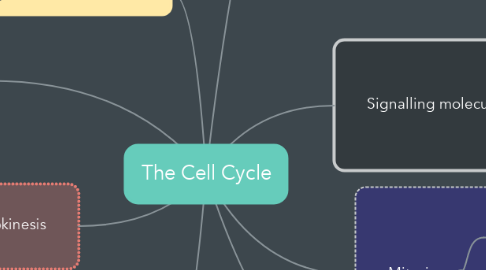
1. Takes place in Eukaryotic cells
2. Cytokinesis
2.1. The cell is split into two daughter cells each having one nucleus.
3. PMAT
3.1. Prophase
3.1.1. Chromatin becomes visible in the nucleus
3.1.2. Centrioles move to opposite ends of the cell
3.2. Metaphase
3.2.1. Spindle fibers surround the chromosomes at the nucleus making sure each new nucleus will receive a copy of a chromosome
3.3. Anaphase
3.3.1. The pairs of chromosome go to the kinetochore and separate and move to opposite ends of the cell
3.4. Telophase
3.4.1. Chromatids (individual copy of DNA) move to opposite poles of the cell
4. If the regulation of cells goes wrong :
4.1. Causes Cancer
4.1.1. Cancer cell are dividing out of control
4.1.1.1. Leads to the development of tumor
4.1.2. The cell did not obeys signal and continue to divide
5. Signalling molecules
5.1. Protein
5.1.1. Cyclin
5.1.1.1. Cyclins activate cyclin dependent kinases (CDKs)
5.1.2. Protein Kinases
5.1.2.1. Enzymes that active or deactivate othersproteins by phosphorylation
5.1.2.1.1. phosphorylation : Act of adding phosphate group to another molecules
6. Interphase
6.1. Cellular activity that is occur because new cells need their own organelles.
6.1.1. The cell cycle control system
6.1.1.1. Gap 1
6.1.1.1.1. Cell grow, develop, and gain ATP
6.1.1.1.2. Restriction check point : Get the signal to encounter or enter G0
6.1.1.2. Synthesis (S)
6.1.1.2.1. DNA is copied
6.1.1.2.2. S checkpoint : Ensures DNA replication has occurred properly
6.1.1.3. Gap 2 (G2)
6.1.1.3.1. Energy gained is used to divide the cell during mitosis
6.1.1.3.2. The cell double checks the duplicated chromosomes for errors and making any repairs
6.1.1.3.3. G2 checkpoint : Ensures the cell is ready to divide
6.1.1.4. Mitotic (M)
6.1.1.4.1. Cell divides to produce 2 daughter cells
6.1.1.4.2. M checkpoint : Ensures chromosomes are attached to spinales
